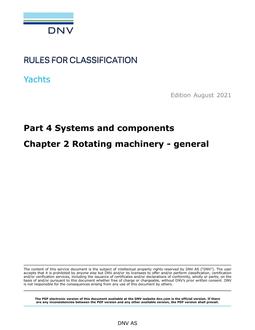-
-
Available Formats
- Availability
- Priced From ( in USD )
-
Available Formats
-
- Secure PDF 🔒
- Immediate download
- $57.00
- Add to Cart
-
- Printed Edition
- Ships in 1-2 business days
- $57.00
- Add to Cart
Customers Who Bought This Also Bought
-

DNV DNV-RU-YACHT PART 4 CHAPTER 2
Priced From $57.00 -

DNV DNV-RU-SHIPS PART 7 CHAPTER 2
Priced From $57.00 -

DNV DNV-CP-0254
Priced From $57.00
About This Item
Full Description
Scope and applications
The standard is applicable to LNG Export and Import Terminal Structures using concrete as the structural material in the support structure as defined in 302 and 303 below.
LNG Export Terminal Structures
LNG export terminals are, by nature, located near the coast and are designed to liquefy the natural gas which will then be loaded onto LNG carriers. An LNG export terminal generally includes:
— an incoming natural gas metering and receiving station, including in the case of a two phase incoming pipeline, a slug catcher
— condensate stabilisation and storage
— gas treatment units in which any acid gases, water, heavier hydrocarbons and, if appropriate, mercury which might be present in the incoming gas are extracted
— liquefaction units which produce LNG and within which, ethane, propane, commercial butane, heavier hydrocarbons and nitrogen can be extracted. A proportion of the extracted hydrocarbons can be used as refrigerant make up. A liquefaction unit uses very specific equipment such as cryogenic spool-wound or brazed plate-fin exchangers and high-powered turbo compression units. Two refrigerant cycles in cascade are usually employed
— LNG storage tanks and the relevant loading plants for filling LNG carriers
— generation and/or purchase and distribution of the utilities necessary for the plant to operate (electricity, steam, cooling water, compressed air, nitrogen, fuel gas etc.)
— general off-site installations, (gas and liquid flare systems, effluent treatment, fire fighting systems etc.).
Most of the gas treating steps can be commonly found in gas treatment plant for the production of sales gas. e.g. acid gas removal, dehydration, hydrocarbon dew point and liquid natural gas (LNG) recovery.
LNG Import Terminals
LNG import terminals are designed to receive LNG from LNG carriers, to unload, store and convert it into the gaseous phase for sending it out to the gas network or gas consumers.
Thus an LNG receiving terminal provides several essential functions which are:
— unloading
— storage
— LNG recovery and pressurising
— vaporising
— gas quality adjustment.
Appendices A-D are appended to the standard. These appendices contain guidelines for the design of Terminals in accordance with approach for Land LNG Terminal Structures in accordance with the approach used for the design of Land LNG Terminal Structures modified with the environmental condition of an offshore terminal.
The standard is combining the design and construction experience from the fixed/floating offshore structures DNVOS- C502, DNV Rules for Classification of Ships Pt.5 Ch.5, IMO - IGC Code "the International Code for the Construction and Equipment of Ships Carrying Liquefied Gases in Bulk" and the experience from design and construction of land based storage tank for LNG as presented in EN-1473 and NFPA 59A.
For the detailed design of primary steel containment tanks reference is made to Rules for Classification of Ships Part 5 Chapter 5, IGC- IMO Code, EN-1473 and NFPA 59A.
See Appendices C "General Design Principles LNG Containment Structures" and D "Detailed Structural Design of Containment System" for Guidelines for the design of the primary steel containment tanks in accordance with conventional tanks at land. The environmental impact on offshore terminals are included in these guidelines.
On ships, the IGC-IMO type B independent tanks are widely used. These tanks are designed, constructed and inspected in accordance with the requirements in the IGC - IMO Code. The DNV Rules for Classification of Ships Part 5 Section 5 gives detailed requirements for the design of Independent tanks Type B.
Site specific data shall be considered in the design of Terminal Structures and Containment Systems.
The development and design of new concepts for LNG terminals requires a systematic hazard identification process in order to mitigate the risk to an acceptable risk level. Hazard identification is therefore a central tool in this standard in order to identify hazards and mitigate these to an acceptable risk level.




